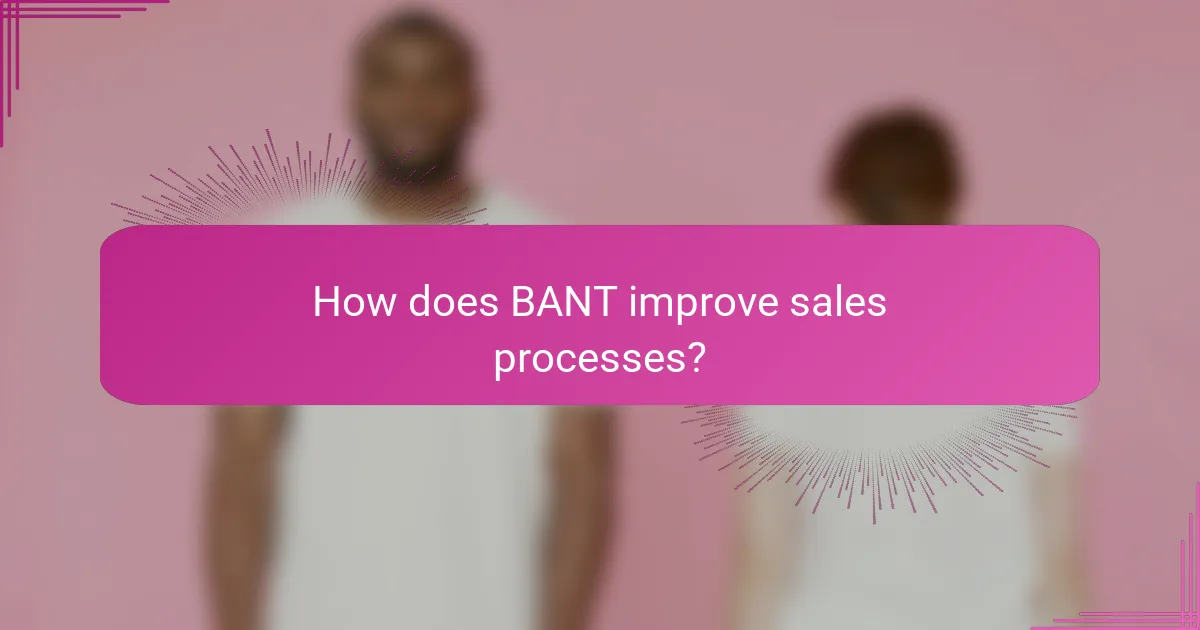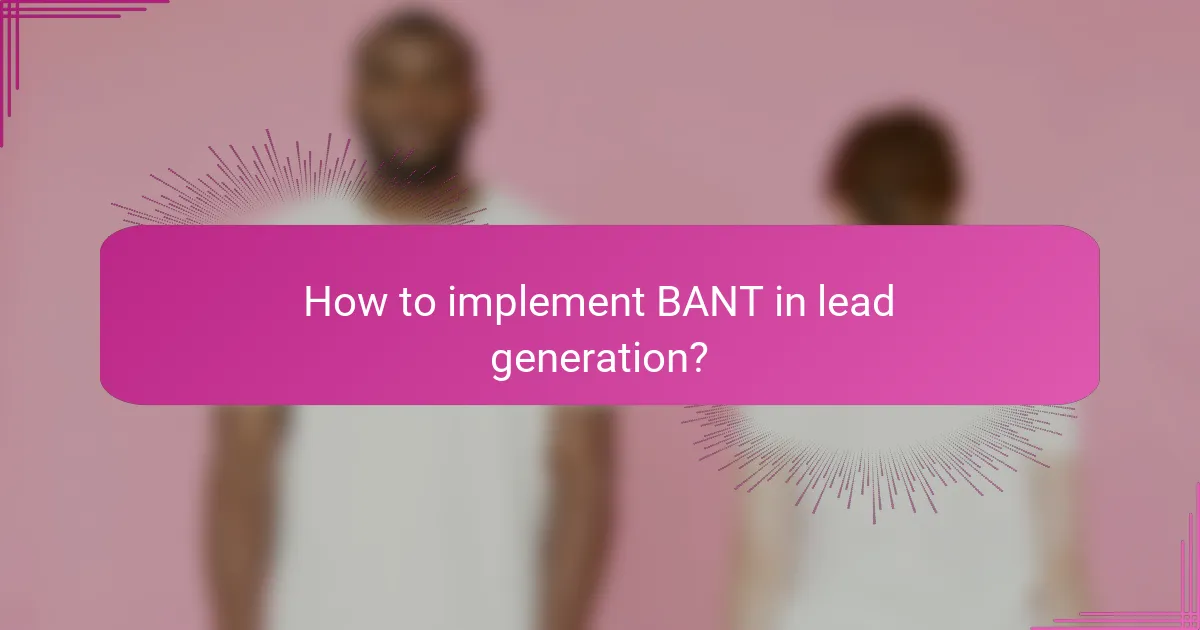BANT is a strategic framework that enhances sales processes by evaluating potential leads through four key components: Budget, Authority, Need, and Timeline. By assessing these elements, sales teams can prioritize prospects and focus their efforts on opportunities with the highest likelihood of conversion, ultimately improving their overall effectiveness in lead generation.

How does BANT improve sales processes?
BANT enhances sales processes by providing a structured framework for evaluating potential leads based on Budget, Authority, Need, and Timeline. This approach helps sales teams prioritize prospects, ensuring they focus on opportunities that are most likely to convert into sales.
Increases lead qualification efficiency
BANT streamlines the lead qualification process by allowing sales teams to quickly assess whether a prospect meets essential criteria. By asking targeted questions about budget, authority, need, and timeline, teams can eliminate leads that do not fit their ideal customer profile.
For example, if a prospect indicates they lack the budget for a product priced at several thousand dollars, the sales team can redirect their efforts to more promising leads. This efficiency saves time and resources, enabling teams to focus on high-potential opportunities.
Enhances sales team alignment
Implementing BANT fosters better alignment within sales teams by creating a common language and understanding of lead qualification. When all team members use the same criteria to evaluate prospects, it reduces confusion and ensures everyone is on the same page regarding priorities.
This alignment can lead to improved collaboration, as team members can share insights and strategies based on a unified framework. Regular training sessions on BANT can further reinforce this alignment and keep the team focused on shared goals.
Facilitates targeted marketing strategies
BANT not only aids sales teams but also informs marketing strategies by identifying the specific needs and pain points of target audiences. Understanding the budget and authority of prospects allows marketers to tailor campaigns that resonate with the right segments.
For instance, if a company identifies a segment with a high budget and urgent need, marketing efforts can be directed toward creating premium offerings or time-sensitive promotions. This targeted approach increases the likelihood of engagement and conversion.

What are the components of BANT?
BANT consists of four key components: Budget, Authority, Need, and Timeline. Each element helps sales professionals qualify leads by assessing financial capacity, decision-making power, customer requirements, and project urgency.
Budget: financial constraints and allocations
Understanding the budget is crucial for determining if a potential customer can afford your product or service. This involves identifying their financial constraints and how much they are willing to allocate for a solution.
To assess budget, ask open-ended questions about their financial planning and any existing allocations for similar projects. For example, you might inquire if they have a specific budget range in mind, such as $5,000 to $10,000.
Authority: decision-maker identification
Identifying the decision-maker is essential for effective sales communication. This component involves understanding who has the authority to approve purchases and influence decisions within the organization.
Engage with your contacts to clarify their roles and responsibilities. You can ask questions like, “Who else is involved in the decision-making process?” This helps ensure you are speaking with the right person or can connect with them directly.
Need: understanding customer pain points
Recognizing the customer’s needs is vital for tailoring your solution effectively. This means delving into their specific pain points and challenges that your product or service can address.
Use probing questions to uncover these needs, such as, “What challenges are you currently facing?” or “What outcomes are you hoping to achieve?” This insight allows you to position your offering as a solution to their problems.
Timeline: urgency and project deadlines
Understanding the timeline helps gauge the urgency of the customer’s needs and when they expect to implement a solution. This component is critical for prioritizing your sales efforts.
Ask about their project deadlines and any external factors influencing their timeline. For instance, inquire if they need a solution within the next quarter or if there are specific events driving their urgency. This information can help you align your sales strategy accordingly.

How to implement BANT in lead generation?
Implementing BANT in lead generation involves assessing the Budget, Authority, Need, and Timeline of potential clients to qualify leads effectively. This structured approach helps sales teams prioritize prospects and tailor their strategies for better conversion rates.
Conduct thorough research on prospects
Researching prospects is crucial for understanding their financial capacity, decision-making power, specific needs, and urgency. Utilize online resources, social media, and industry reports to gather information about potential clients.
Look for insights into their current challenges and goals, which can help you tailor your approach. For example, if a prospect is actively seeking solutions to reduce costs, they may have a defined budget and a pressing need.
Utilize CRM tools for tracking
Customer Relationship Management (CRM) tools are essential for tracking interactions and managing data related to prospects. These platforms can help you log details about each lead’s BANT criteria, making it easier to prioritize follow-ups and tailor communications.
Ensure your CRM is set up to categorize leads based on their budget, authority, need, and timeline. This organization allows for more efficient sales processes and better alignment with prospects’ expectations.
Engage in consultative selling techniques
Consultative selling focuses on understanding the prospect’s needs and providing tailored solutions rather than pushing a product. This approach aligns well with BANT, as it encourages open dialogue about the prospect’s budget, authority, needs, and timelines.
Ask open-ended questions to uncover deeper insights and demonstrate genuine interest in solving their problems. For instance, inquire about their decision-making process and any constraints they face, which can help you position your offering more effectively.

What are common challenges with BANT?
Common challenges with BANT include misidentifying decision-makers, making inaccurate budget assessments, and overlooking customer needs. Each of these issues can lead to ineffective sales strategies and missed opportunities.
Misidentifying decision-makers
Misidentifying decision-makers can derail the entire BANT process. It’s crucial to accurately identify who has the authority to make purchasing decisions within an organization. Engaging with the wrong individuals can waste time and resources, leading to frustration and stalled negotiations.
To avoid this pitfall, conduct thorough research on the organization’s hierarchy and roles. Utilize LinkedIn or company websites to pinpoint key stakeholders and their responsibilities. Consider reaching out to multiple contacts to confirm who is involved in the decision-making process.
Inaccurate budget assessments
Inaccurate budget assessments can lead to proposals that are either too high or too low, affecting the likelihood of closing a deal. Understanding the customer’s financial constraints is essential for tailoring your offer appropriately. If the budget is underestimated, you risk losing credibility; if overestimated, you may miss out on potential sales.
To improve budget accuracy, ask open-ended questions about financial allocations and priorities. Research industry standards for similar purchases to gauge reasonable budget ranges. Additionally, consider offering flexible pricing options to accommodate different budget scenarios.
Overlooking customer needs
Overlooking customer needs can result in solutions that do not resonate with the target audience. BANT emphasizes understanding the customer’s requirements, but if these needs are not clearly identified, the sales approach can become misaligned. This disconnect can lead to ineffective pitches and lost sales opportunities.
To ensure customer needs are prioritized, engage in active listening during conversations and ask probing questions. Use feedback from previous interactions to refine your understanding of what the customer values most. Regularly revisiting and validating these needs can help maintain alignment throughout the sales process.

How to overcome BANT implementation challenges?
To effectively overcome BANT implementation challenges, organizations should focus on continuous training, feedback mechanisms, and adapting strategies based on real-world experiences. This approach enhances the understanding and application of Budget, Authority, Need, and Timeline in sales processes.
Regular training for sales teams
Regular training sessions for sales teams are essential to ensure they are well-versed in the BANT framework. These sessions should cover not only the basics but also advanced techniques for identifying and qualifying leads based on budget, authority, need, and timeline.
Consider implementing monthly workshops or quarterly retreats that include role-playing scenarios and case studies. This hands-on approach allows sales representatives to practice their skills in a controlled environment, leading to better retention and application in real sales situations.
Utilize feedback loops for improvement
Establishing feedback loops is crucial for refining the BANT process. After each sales cycle, gather insights from team members about what worked and what didn’t in identifying and qualifying leads. This can involve surveys, one-on-one interviews, or team debriefs.
Incorporate this feedback into training materials and sales strategies. For example, if a common challenge is understanding client budgets, adjust training to include more detailed discussions on budget-related questions and negotiation tactics. Regularly updating your approach based on feedback ensures that your sales team remains agile and effective in their BANT implementation.

What tools can assist with BANT analysis?
Several tools can enhance BANT analysis by streamlining the process of assessing Budget, Authority, Need, and Timeline. Utilizing CRM software, lead tracking systems, and analytics platforms can provide valuable insights and facilitate informed decision-making.
HubSpot for CRM and lead tracking
HubSpot is a powerful tool for managing customer relationships and tracking leads, making it ideal for BANT analysis. Its CRM features allow users to organize contacts, categorize leads based on their budget and authority, and track interactions over time.
With HubSpot, you can create custom properties to capture specific BANT criteria, such as budget range or decision-making authority. This enables sales teams to prioritize leads effectively and tailor their approach based on the identified needs and timelines of potential clients.
Additionally, HubSpot’s reporting tools can help visualize data trends, providing insights into how different factors like budget constraints impact the sales cycle. Regularly reviewing these reports can guide strategic adjustments to your sales tactics, ensuring alignment with client expectations.
